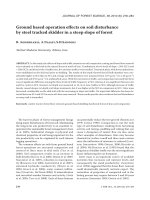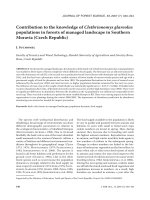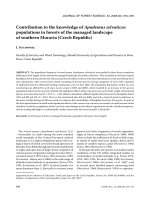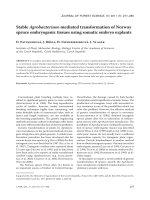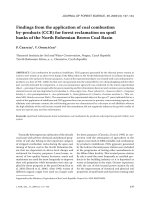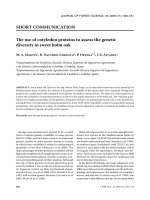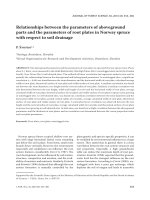Báo cáo lâm nghiệp: "Post-fire resprouting ability of 15 non-dominant shrub and tree species in Mediterranean areas of NE Spain" pot
Bạn đang xem bản rút gọn của tài liệu. Xem và tải ngay bản đầy đủ của tài liệu tại đây (135.18 KB, 8 trang )
Ann. For. Sci. 64 (2007) 883–890 Available online at:
c
INRA, EDP Sciences, 2007 www.afs-journal.org
DOI: 10.1051/forest:2007070
Original article
Post-fire resprouting ability of 15 non-dominant shrub and tree species
in Mediterranean areas of NE Spain
Lidia Quevedo,AnselmRodrigo
*
,JosepMariaE
spelta
Unit of Ecology and Center for Ecological Research and Forestry Applications (CREAF), Autonomous University of Barcelona,
08193 Bellaterra (Barcelona), Spain
(Received 19 February 2007; accepted 27 April 2007)
Abstract – Post-fire resprouting ability of the non-dominant tree and shrub species of the Mediterranean Basin has not yet been experimentally tested,
although this group contributes to maintain the richness of Mediterranean plant communities. In this study, we have analyzed the post-fire recovery
ability of 15 woody species that occur in relatively low abundance in dry and sub humid Mediterranean areas in NE of Spain. The main goals have been:
(i) to determine experimentally the post-fire resprouting ability of these species and (ii) to compare the abundance of these species in areas affected
by wildland fires and in unburned areas. We have observed a high resprouting ability after prescribed burning of most species except for Juniperus
communis and J. phoenicea which showed a null resprouting. As the species with high resprouting ability showed similar presence in burned and
unburned areas, we can conclude that wildfires are not a factor that constrains the presence of these species in Mediterranean woodlands. However, we
found a reduction in the abundance of J. communis and J . phoenicea at the regional level after wildland fires.
distribution area / prescribed burning / resprouting / woody species / Juniperus
Résumé – Capacité à rejeter de souche de 15 espèces d’arbr es et d’arbustes secondaires de la région méditerranéenne après incendie. La capa-
cité à rejeter de souche après incendie d’espèces d’arbres et d’arbustes non dominants de la région méditerranéenne est peu connue malgré l’importance
de la contribution de ce groupe à la richesse des communautés végétales. Dans cette étude, nous avons analysé la capacité à rejeter de souche de 15
espèces ligneuses présentes en faible abondance dans les zones semi arides et subhumides méditerranéennes du nord-est de l’Espagne. Les principaux
objectifs étaient : (i) de déterminer expérimentalement la capacité de rejeter après incendie et (ii) de comparer l’abondance de ces espèces dans des
zones brûlées et non brûlées. Toutes les espèces testées présentaient une grande capacité à rejeter de souche à l’exception de Juniperus communis et J.
phoenicea, qui ont montré une incapacité complète à rejeter de souche après incendie. Les espèces présentant une grande capacité de rejet présentent des
abondances similaires dans des zones brûlées et non brûlées. Nous pouvons conclure que les incendies ne sont pas le facteur limitant leur présence dans
les forêts méditerranéennes. Au contraire, les espèces sensibles à faible capacité de rejet comme J. communis et J. phoenicea, ont vu leur abondance
baisser à l’échelle régionale après incendie.
distribution des espèces / incendies de forêt / rejet de souche / brûlis / Juniperus
1. INTRODUCTION
Wildfires are considered the most important disturbance in
Mediterranean-type ecosystems [38]. During recent decades,
the number and, especially, the surface burned by forest fires
in the Mediterranean Basin has increased dramatically with
some catastrophic wildland fires being responsible for most of
the burned areas [39]. Moreover, in recent years, a greater inci-
dence of fire in non-fire-prone sub-Mediterranean areas along
the east coast of the Iberian Peninsula has been detected (i.e.,
in Catalonia the percentage of surface burned in these areas in-
creased from 23–26% in the seventies and eighties to 36% in
the nineties). Thus, fires are gradually disturbing greater land
surfaces and starting to threaten plant communities distributed
in areas with a sub-humid Mediterranean climate, which tradi-
tionally have been less influenced by this type of disturbance.
Many Mediterranean plant species exhibit the ability to re-
cover readily after fire, either through the germination of pro-
* Corresponding author:
tected seeds stored in the soil seed bank or in the canopy [24],
or by resprouting from aerial or subterranean fire-resistant
buds [17, 21, 26, 38]. The resprouting ability of some of the
most dominant tree and shrub species in the Mediterranean
Basin is well known (e.g. [1, 6, 20, 23, 28]). The extensive
knowledge about the post-fire behaviour of these dominant
forest species contrasts with the lack of information about
the recovery of other non-dominant and less abundant tree
and shrub species. Many of these less abundant species are
of great importance in Mediterranean-type forest communi-
ties because: (i) they contribute to maintain the richness of
Mediterranean forest communities [24] which, in general, tend
to be dominated by one or two tree species [25, 37] and (ii)
they play an important role as a source of pollen for insects,
as well as fleshy fruits consumed by insects, mammals and
birds [8, 13,18].
As far as we know, the post-fire resprouting ability of
most of these non-dominant tree and shrub species present
in the Mediterranean Basin has not yet been experimentally
Article published by EDP Sciences and available at or />884 L. Quevedo et al.
tested. However, for some of them, this potential ability has
been partly envisaged after other disturbances such as thin-
ning [5, 19]. The potential resprouting ability after fire can be
vital to the persistence of these species, because the latter do
not potentially form a seed bank resistant to fire in the soil or
in the canopy [23]. Therefore, depending on their resprouting
ability after fire, some of these species could either disappear
or even achieve greater dominance in the community, espe-
cially in those cases where the post-fire regeneration of the
dominant species is very limited [31, 33].
In this study, we have analysed the post-fire resprouting
ability of 15 forest tree and shrub species broadly distributed
throughout humid and dry Mediterranean areas of the NE
Iberian Peninsula, but present in low abundance, although
most of them are abundant and representative of the Eurosi-
berian region. For this study we selected species of the genus
Acer, Ilex, Sorbus, Amelanchier, Cornus, Crataegus, Junipe-
rus, Prunus and Viburnum. The main goals of this study have
been to determine for each of the studied species: (1) whether
or not they have post-fire resprouting ability, (2) if there is a
relationship between resprouting vigour and pre-fire size of
the individuals and (3) whether the abundance of these species
in their natural distribution areas is related to their ability
to recover after fire. The first two goals of this study have
been tested using a prescribed burning experiment. The third
goal has been addressed in areas affected by wildland fires
through a comparison of the presence/absence of these species
in burned and unburned neighbouring areas.
2. MATERIAL AND METHODS
2.1. Study species
For this study, a total of 15 tree and shrub species distributed
throughout the region of Catalonia (NE Iberian Peninsula) were cho-
sen. We included deciduous species: Acer campestre L., A . mon-
spessulanum L., A. opalus Mill., Sorbus domestica L., S. torminalis
(L.) Crantz, Amelanchier ovalis L., Cornus sanguinea L., Cratae-
gus mono gyna L., Prunus spinosa L. and Viburnum lantana L.; ev-
ergreen broad-leafed: Ilex aquifolium L. and Viburnum tinus L.; and
evergreen needle-leafed: Juniperus communis L., J. oxycedrus L. and
J. phoenicea L., In sub-humid and dry Mediterranean areas of NE
Spain, the abundance of these species is relatively low and they are
either situated in the understory or they form small clumps in woods
dominated mainly by Pinus or Quercus species.
2.2. Post-fire respr outing ability
The study has been conducted at seven sites with a Mediterranean-
type climate located in Catalonia, NE Iberian Peninsula. In the areas
included in the study, mean annual precipitation ranged from 595 to
853 mm, mean annual water deficit (annual potential evapotranspi-
ration – annual precipitation) ranged from –17 to 404 mm and mean
annual temperatures between 10.4 and 13.2
◦
C. All the sites had an
overstory dominated by Pinus spp. In all study sites, from March
2003 until May 2004, about 30 individuals of each species were sam-
pled, with the exception of A. monspessulanum, for which just 15
were found. The whole set of individuals were tagged with metallic
tags and positioned with a GPS. For each individual the crown cover
(measuring two perpendicular diameters of the crown and computing
the projection as an ellipse) and total number of stems was deter-
mined. In each stem we measured total height, distance from ground
to beginning of the crown and basal diameter (see Annex 1). With
these data the following calculations were carried out for each indi-
vidual: height of highest stem, mean height of the stems; mean and
minimum distance from the ground to the top of the crown; total basal
area (adding together the basal area of all stems); and equivalent di-
ameter of each individual obtained from the total basal area at ground
level.
During winter and spring of 2003 and 2004, prescribed burnings
were carried out in all study sites (temperatures during the burns rang-
ing from 6.9
◦
C to 18.2
◦
C and with relative humidity never less than
47%). The area burned varied from 0.43 to 4.5 ha. Immediately after
fire, for each sampled individual we estimated an index of fire im-
pact, calculated as the percentage of total individual height achieved
directly by the fire flames (identified by the presence of leaves con-
sumed or charred bark). Between June and October of 2004 (one or
two years after the burning, depending on the site), all tagged indi-
viduals were located and we recorded whether they had resprouted or
not. Moreover, the number of resprouts for each individual, the height
of the three largest ones and the crown cover of the whole set of re-
sprouts was measured. In none of the resprouted individuals was any
effect of vertebrate herbivory detected.
In order to establish a relationship between resprouting vigour and
the pre-fire size, the relationship between different structural vari-
ables measured before and after prescribed burning was analysed. To
avoid spurious relationships, we previously constructed a correlation
table among all pre-fire variables (X). When there appeared to be cor-
relation between two variables, one of them was chosen as the repre-
sentative. After this procedure, all pairs of variables had a correlation
coefficient lower than 0.8. Following this criterion, the variables se-
lected as independent and representative of the pre-fire size were: the
number of stems, the maximum stem height and the basal area of
each individual. The same was done for the post-fire variables (Y)
and the dependent variables selected as representative of the post-fire
resprouting vigour were: basal area, the number of resprouts and the
height of the dominant resprout. Finally, with the selected variables,
we calculated step by step regression for each species between the
pre- and the post-fire size variables.
Prescribed burning was carried out over two consecutive years
(2003 and 2004). Thus, when taking post-fire measurements, indi-
viduals with 1 or 2 years of regeneration could be found. In order to
analyse the relationship between the resprouting vigour and the pre-
fire individual size, in those species where the great majority of indi-
viduals were in one of the two regeneration ages, only the individuals
of the most numerous group were selected for the regressions. Only
in the case of A. ovalis, which did not belong to a majority group,
were all the individuals included in the study and the data from both
regeneration ages was analysed separately.
In order to assess which species had the greatest growth ability
after fire, the annual growth of all resprouts was compared. For the
one-year-old resprouts, the measurement of the highest resprout in the
field was used. In the case of two-year-old resprouts, the dominant re-
sprout height was divided by two in order to obtain comparable data.
Height differences among species were tested using two separate one-
way ANOVA, one for the shrub species and another for tree species.
When there were significant differences between species, we carried
Post-fire resprouting of woody species 885
Table I . Resprouting ability after prescribed burning, measured as the percentage of individuals resprouting after fire, and degree of fire impact,
measured as the percentage (mean ± S.D.) of the individual achieved directly by the fire (see Methods). The number of localities where the
species is present is shown in the last column. Species have been grouped according to their very high, high or non-resprouting ability after
prescribed burning.
Species Resprouted
individuals
Non resprouted
individuals
Resprouting
ability (%)
Fire impact
degree (%)
Number
of localities
Very high resprouting ability after prescribed burning
A. opalus 30 0 100 100 ± 01
A. ovalis 34 0 100 100 ± 06
S. domestica 33 0 100 93 ± 24 3
S. torminalis 36 0 100 100 ± 01
V. lantana 31 0 100 94 ± 21 3
V. tinus 33 0 100 93 ± 24 1
C. sanguinea 29 1 97 100 ± 03
A. campestre 34 2 94 93 ± 22 4
C. monogyna 32 2 94 100 ± 03
P. spinosa 28 2 93 100 ± 04
A. monspessulanum 14 1 93 100 ± 04
High resprouting ability after prescribed burning
J. oxycedrus 26 6 81 40 ± 38 4
I. aquifolium 29 10 74 99 ± 32 1
Non resprouting ability after prescribed burning
J . communis 037 0 65± 32 3
J. phoenicea 033 0 43± 31 2
out post-hoc comparison using the Tukey test. In all statistical anal-
yses, residuals were systematically inspected in order to check for
normality and homoscedasticity, and data were log or arcsine square
root transformed when necessary
2.3. Presence of the studied species in the burned and
unburned areas
The comparison of the presence of the studied species in burned
areas by wildland fires versus unburned areas was done by overlay-
ing different maps obtained with the SIG MiraMon package [30].
The first step was to identify and define the areas burned between
1975 and 2002 of more than 30 ha, from a selection of fire maps [34].
Most of them occurred in summer and were intense canopy fires. Sec-
ondly, around each burned zone an area of 3000 m from the limit was
defined with the aim of creating a neighbouring unburned zone, com-
parable with the zone which had been burned. Then we overlapped
the actual distribution area for each species with the fire map and the
neighbouring unburned zones. In the resulting map we counted, for
each species, the number of plots of the Third National Forest Inven-
tory of Spain (IFN3) within the species area distribution and in the
burned areas where the species was present. Then, for each species,
the same total number of plots in burned areas was randomly selected
from the set of plots of the unburned areas and we counted the num-
ber of plots where the species was present. Finally, using an χ
2
test,
we tested differences in the number of plots where the species was
present in burned and unburned areas.
3. RESULTS
The 15 species studied showed three differentiated types
of responses, according to their resprouting ability after pre-
scribed burning (Tab. I). Eleven species exhibit a very high
resprouting ability, with more than 90% of the individuals re-
sprouted (Tab. I). A second group of two species (I. aquifolium
and J. phoenicea) present a considerable percentage of re-
sprouting individuals (74–81%), although lower than the for-
mer group. In both groups all the individuals resprouted from
the root crown. Finally, two species (J. phoenicea and J. com-
munis) had no resprouting ability at all. After the prescribed
burning, 73% of all trees and shrubs studied appeared to be
completely charred, while the aerial part of the remaining in-
dividuals also died (suffocated) as a consequence of the ex-
tremely high temperatures reached (Tab. I). For those two
species resprouting with intermediate values, no differences in
the degree of charring was observed between resprouting in-
dividuals and non-resprouting ones, neither for I. aquifolium
(t = 1.09, p = 0.26 and d.f. = 35) nor for J. oxycedrus
(t = 0.59, p = 0.59 and d.f. = 6).
For all species, resprouting vigour (Tab. II) was related
to the pre-fire size of the individual (see Annex 1 and 2 for
the mean values of the morphological variables before and
after prescribed burning). However, this relationship differed
among species, depending on the variables used to estimate
resprouting vigour: either the number of new resprouts or the
height of the dominant resprout. Pre-fire basal area was the
886 L. Quevedo et al.
Table II. P-values and correlation coefficients (R
2
) of the stepwise regression between pre-fire characteristics of individuals (total basal area
(TBA), height of highest stem (Max. height) and number of stems) and the number of resprouts after fire (A) and the height of the dominant
resprout after fire (B). Significant terms included in the regression model are shown as positive (+), negative (–) or ns = non significant terms.
Number of individuals (N) and regeneration age (1 or 2 y) are also shown.
Species N TBA Max height Number of stems p-value R
2
Regeneration age (yrs)
A. Number of resprouts after fire
A. campestre 32 + ns + < 0.0001 0.655 1
A. monspessulanum 12 ns ns ns – – 2
A. opalus 30 + ns ns 0.0112 0.209 1
A. ovalis 21 + ns ns < 0.0001 0.615 2
12 ns ++< 0.0001 0.872 1
C. sanguinea 28 + ns ns 0.0378 0.156 2
C. monogyna 23 + ns ns 0.0066 0.302 1
I. aquifolium 29 + ns ns 0.0067 0.242 1
J. oxycedrus 20 ns + ns 0.0261 0.246 1
P. spinosa 24 ns ns ns – – 1
S. domestica 31 ns ns ns – – 1
S. torminalis 36 + ns + < 0.0001 0.590 2
V. lantana 29 + ns ns 0.0356 0.153 2
V. tinus 30 ns ns + < 0.0001 0.703 1
B. Height of the dominant resprout after fire
A. campestre 32 ns + ns < 0.0001 0.545 1
A. monspessulanum 12 ns + ns 0.0072 0.530 2
A. opalus 30 + ns ns < 0.0001 0.633 1
A. ovalis 21 + ns ns < 0.0001 0.604 2
12 ns ns ns – – 1
C. sanguinea 28 ns + ns 0.0144 0.209 2
C. monogyna 23 + ns ns 0.0423 0.182 1
I. aquifolium 29 ns ns ns – – 1
J. oxycedrus 20 ns ns ns – – 1
P. spinosa 24 ns + ns 0.0046 0.312 1
S. domestica 31 ns + ns 0.0008 0.327 1
S. torminalis 36 + ns ns < 0.0001 0.801 2
V. lantana 29 ns ++< 0.0001 0.738 2
V. tinus 30 ++ ns < 0.0001 0.769 2
best predictor of the number of new resprouts occurring in 8
out of 13 species, followed by pre-fire number of stems (4 out
of 13 species) and finally, maximum height (Tab. IIA). Only
for A. monspessulanum,andP. spinosa was the number of new
resprouts independent of the size of the individuals before the
fire. On the other hand, for the height of the dominant resprout,
in 6 out of 13 species there was a positive relationship with the
pre-fire height of the individuals (Tab. IIB), the second vari-
able being the basimetric area (5 out of 13 species) and, finally,
the number of stems (only one species). None of the parame-
ters analysed exerted an effect on the dominant resprout height
of A. ovalis, I. aquifolium and J. oxycedrus.
Figure 1 shows the annual growth of all the species able
to resprout after prescribed burning. Significant differences
in growth were detected between both tree species (ANOVA
F = 19.7, p < 0.0001 and d.f. = 5) and shrubs (ANOVA,
F = 30.1, p < 0.0001 and d.f. = 6). Among the tree species, A.
campestre and, to a lesser extent, S. domestica, were those with
the highest post-fire growth. I. aquifolium presented lower
growth than other species, while height of new resprouts was
only 9% of its pre-fire height. Regarding shrub species, P.
spinosa and C. monogyna had the highest growth, the other
species barely surpassing 20 cm in height.
A comparison of the presence of the studied species in ar-
eas burned by wildland fires and unburned neighbouring ar-
eas is presented in Table III. Four of the species analysed
did not show any significant difference in their presence be-
tween burned and unburned zones. However, A. ovalis and
J. phoenicea showed a significant reduction in their pres-
ence in burned versus unburned zones, while the presence of
Post-fire resprouting of woody species 887
J. communis was not detected in burned plots, although the
presence of this species was also relatively low in neighbour-
ing unburned zones.
4. DISCUSSION
Most of the 15 species analysed had high resprouting abil-
ity after prescribed burning; with the exception of J. commu-
nis and J. phoenicea, which had no resprouting ability at all.
Moreover, for the 13 species that resprouted, the percentage of
resprouting was very high, attaining values higher than 90%
in most cases and even 100% in 6 species. These values are
similar to those experimentally registered for dominant for-
est tree and shrub species in Mediterranean-type ecosystems
with well-known resprouting ability after fire [4,20,22,28,32].
Interestingly, resprouting ability was not conditioned by the
fire impact degree experienced (e.g., Acer sp. individuals were
completely burned but all of them resprouted, while J. com-
munis and J. phoenicea individuals were less severely burned
but only 65–43% of them resprouted, see Tab. I).
In V. tinus and J. oxycedrus, the resprouting values obtained
in this study were higher than those registered by López Soria
and Castell (1992) (100 and 83%. in our study vs. 83 and 55%,
respectively). Our higher values could be related to the fact
that the study sites were affected by prescribed burnings in-
stead of wildland fires. Vegetation response to fire can vary
widely, depending on the burning season [3, 36]. In particular,
in Mediterranean ecosystems, resprouting ability after sum-
mer wildland fires could be lower than after prescribed burn-
ing because: (i) prescribed burning generally reaches lower in-
tensities than wildland fires [2, 3, 16] and (ii) summer water
stress can reduce resprouting vigour [1]. However, it is worth
mentioning that for those species which in this study have
shown intermediate resprouting values, such as I. aquifolium
and J. oxycedrus, those individuals which did not resprout did
not suffer greater burning intensities than those which had re-
sprouted. In this context, the influence of other environmental
variables in the resprouting process, such as topographic posi-
tion [15] and resource availability [7], should be considered as
a possible explanation of the above-mentioned differences.
As shown in Tables IIA and IIB, resprouting vigour was
related with the pre-fire size of the individual [22]. Although
there were some species-specific differences, in general, in-
dividuals that were bigger in terms of basimetric area or
their greater number of stems produced more resprouts after
disturbance [9–11, 32]. This pattern has been explained by the
presence of a greater number of potential buds forming re-
sprouts (bud bank) in larger individuals [4,35,40]. Conversely,
the analysis of the effect of pre-fire height of the individual
on the height of the dominant new resprouts has been more
heterogeneous, with a major influence of basal area in some
species and pre-fire height in others (Tab. IIB). The lack of
a clear relationship between the height of new resprouts af-
ter a disturbance and pre-fire size has been observed in other
studies, and has been explained by the effect that some envi-
ronmental factors (i.e., shadow) could have on the height of
resprouts or a major dependence of this variable on resource
01020304050607080
A. campestre
A
. monspessulanum
A. opalus
I. aquifolium
S. domestica
S. torminalis
Annual growth (cm)
a
c
ab
d
c
bc
A)
0 10203040506070
A. ovalis
C. sanguinea
C. monogyna
J. oxycedrus
P. spinosa
V. lantana
V. tinus
Annual growth (cm)
a
c
a
c
c
c
b
B)
Figure 1. Mean ± SE annual growth after prescribed burning of the
dominant resprouts of tree (A) and shrub (B) species. Significant dif-
ferences among species according to the Tukey test are shown with
different letters.
availability and site quality [7, 10, 15]. Despite the above-
mentioned differences between species, it is important to stress
that in none of the species were the number and height of new
resprouts totally independent of pre-fire size of the individu-
als. This fact, coupled with the high resprouting ability shown
by most species, suggests that fire does not cause a significant
change in the size structure of the population.
Due to historical management practice, most of the studied
species are usually found suppressed in the understory of Pi-
nus sp. and Quercus sp. forests, under shadow conditions and
low growth. According to our results, for some species, a high
annual growth of the dominant resprouts was found (Fig. 1
and Annex 2). Thus, after the elimination of the dominant
trees of the community by fire, this rapid recovery suggests
that post-fire conditions could allow some of these species to
become dominant in their forest formations. This could oc-
cur especially with A. campestre and S. domestica (with the
highest growth) but also with A. monspessulanum, A. opalus
and S. torminalis (Fig. 1). This pattern would be especially
888 L. Quevedo et al.
Table III. Percentage of the IFN3 forestry inventory plots included in the distribution area of each species where the species is present within
burned areas (wildland fires between 1975 and 2002) and within neighbouring unburned areas (see Methods for details). When a χ
2
test could
be used for comparison p-value is shown. A significantly lower presence of the species in burned areas is indicated as (↓) and non-significant
differences as (=). N is the total number of burned or unburned plots used in the comparison. Categories of resprouting ability are defined in
Table I.
% of inventoried plots
Burned Unburned p- value Trend N
Very high resprouting ability
Acer monspessulanum 3 2 105
Acer opalus 1 3 102
Amelanchier ovalis 7 16 0.045 ↓ 122
Cornus sanguinea 6 6 0.802 = 143
Crataegus monogyna 11 11 1.000 = 167
Prunus spinosa 6 6 1.000 = 157
High resprouting ability
Juniperus oxycedrus 1 5 0.055 = 117
Non resprouting ability
J uniperus communis 0 3 125
Juniperus phoenicea 3 13 0.0278 ↓ 69
important in those burned areas occupied by pine tree species
without resprouting ability and a low seedling establishment
after fire [31,33].
The presence of the species included in this study in for-
est inventories is usually low, it being difficult to establish
their regional distribution from forest databases. As a conse-
quence, differences in presence in burned vs. unburned areas
could only be statistically evaluated for 6 of the species stud-
ied. Despite these difficulties, it was possible to establish that
all species with similar presence in burned and unburned ar-
eas have also exhibited a high resprouting level. A. ovalis is
an exception because, despite its very high resprouting abil-
ity (Tab. I), its presence seems to diminish in burned areas
(Tab. III). On the other hand, it should be mentioned that none
of the species have shown a significant increase of their pres-
ence in burned areas. This fact suggests that these species are
able to maintain their pre-fire populations through resprouting,
but they have a low establishment ability of new individuals in
burned areas.
Despite the relatively favourable conditions when pre-
scribed burning was conducted (winter and spring), two
species (J. phoenicea and J. communis) have shown a null re-
sprouting ability, as suggested by previous studies after wild-
land fires [14,23,27]. Remarkably, both species are able to sur-
vive other types of disturbances (e.g., intensive grazing [12]).
Due to this inability to resprout after fire and the fact that these
species do not form seed banks resistant to fire, maintenance
of populations in burned areas will depend on the arrival of
propagules from unburned edges. The increase in recent years
of large fire events in the Mediterranean Basin [29] constrains
the arrival of propagules. Furthermore, J. communis recruit-
ment only occurs in optimal precipitation conditions [14]. On
the other hand, it is well known that J. phoenicea germina-
tion is slow and difficult and that seed production is irregular,
and that it may take 50 years for plants to reach sexual ma-
turity [27]. These constraints imply that only the inclusion of
specific measures in restoration plans would prevent a reduc-
tion in the populations of these two species at regional level
after fire events.
Acknowledgements: Thanks are due to M.J. Broncano, Javier Re-
tana and Montserrat Vilà for their very helpful comments on an
earlier draft of the manuscript and to GRAF (Grup de Recolza-
ment d’Actuacions Forestals) for carrying out prescribed burning.
This research was partly funded by INTERREG III (EU) project
I3A-1-100-E and by INIA project RTA2005-00100-C02.
REFERENCES
[1] Bonfil C., Cortés P., Espelta J.M., Retana J., The role of disturbance
in the coexistence of the evergreen Quercus ilex and the deciduous
Quer cus cer rioides, J. Veg. Sci. 15 (2004) 423–430.
[2] Bradstock R.A., Auld T.D., Soil temperatures during experimental
bushfires in relation to fire intensity: consequences for legume ger-
mination and fire management in south-eastern, Aust. J. Appl. Ecol.
32 (1995) 76–84.
[3] Brockway D.G., Gatewood R.G., Paris R.B., Restoring fire as an
ecological process in shortgrass prairie ecosystems: initial effects
of prescribed burning during the dormant and growing seasons, J.
Environ. Manage. 65 (2002) 135–152.
[4] Canadell J., Lloret F., López Soria L., Resprouting vigour of
two Mediterranean shrub species after experimental treatment,
Vegetatio 95 (1991) 119–126.
[5] Clennett C., Viburnum tinus ‘Eve Price’. Viburnaceae, Royal
Botanic Gardens, Kew, Blackwell Publishing Ltd, Oxford, 2004.
[6] Clemente A.S., Rego F.C., Correia O.A., Demographic patterns and
productivity of post-fire regeneration in Portuguese Mediterranean
maquis, Int. J. Wildl. Fire 6 (1996) 5–12.
[7] Cruz A., Perez B., Quintana J.R., Moreno J.M., Resprouting in the
Mediterranean-type shrub Erica australis affected by soil resource
availability, J. Veg. Sci. 13 (2002) 641–650.
Post-fire resprouting of woody species 889
[8] Debussche M., Isenmann P., Bird-dispersed seed rain and seedling
establishment in patchy Mediterranean vegetation, Oikos 69 (1994)
414–426.
[9] Ducrey M., Turrel M., Influence of cutting methods and dates on
stump sprouting in holm oak (Quercus ilex L.) coppice, Ann. Sci.
For. 49 (1992) 449–464.
[10] Espelta J.M., Retana J., Habrouk A., Resprouting patterns after fire
and response to stool cleaning of two coexisting Mediterranean
oaks with contrasting leaf habits on two different sites, For. Ecol.
Manage. 179 (2003) 401–414.
[11] Espelta J.M., Retana J., Habrouk A., Response to natural and sim-
ulated browsing of two Mediterranean oaks with contrasting leaf
habit after a wildlife, Ann. For. Sci. 63 (2006) 441–447.
[12] Fernández-Guillen M.D., Estudio comparativo de la vegetación
leñosa de un área representativa de la Sierra de Guadarrama,
Ph.D. thesis, Universidad complutense de Madrid, 1996,
/>[13] García D., Obeso J.R., Martinez I., Spatial concordance between
seed rain and seedling establishment in bird-dispersed trees: does
scale matter? J. Ecol. 93 (2005) 693–704.
[14] García D., Zamora R., Hódar J.A., Gómez J.M., Age structure of
J uniperus communis L. in the Iberian peninsula: Conservation of
remnant populations in Mediterranean mountains, Biol. Conserv. 87
(1999) 215–220.
[15] Gracia M., Retana J., Effect of site quality and shading on sprout-
ing patterns of holm oak coppices, For. Ecol. Manage. 188 (2004)
39–49.
[16] De Las Heras J., Bonilla M., Martinez L.W., Early vegetation dy-
namics of Pinus tropicalis Morelet forests after experimental fire
(W Cuba), Ann. For. Sci. 62 (2005) 771–777.
[17] Hodgkinson K.C., Sprouting success of shrubs after fire: height-
dependent relationships for different strategies, Oecologia 115
(1998) 64–72.
[18] Hulme P.E., Post-dispersal seed predation and the establishment of
vertebrate dispersed plants in Mediterranean shrublands, Oecologia
111 (1997) 91–98.
[19] Kollmann J., Grubbs P.J., Viburnum lantana L. and Viburnum opu-
lus L. (V. lobatum Lam., Opulus vulgaris Borkh.), J. Ecol. 90 (2002)
1044–1070.
[20] López-Soria L., Castell C., Comparative genet survival after fire in
woody Mediterranean species, Oecologia 53 (1992) 493–499.
[21] Lloret F., Fire, canopy cover and seedling dynamics in
Mediterranean shrubland of northeastern Spain, J. Veg. Sci. 9
(1998) 417–430.
[22] Lloret F., López-Soria L., Resprouting of Erica multiflora after ex-
perimental fire treatments, J. Veg. Sci. 4 (1993) 367–374.
[23] Lloret F., Vilà M., Diversity patterns of plant functional types in re-
lation to fire regime and previous land use in Mediterranean wood-
lands, J. Veg. Sci. 14 (2003) 387–398.
[24] Myers N., Mittermeier R.A., Mittermeier C.G., da Fonseca G.A.B.,
Kent J., Biodiversity hotspots for conservation priorities, Nature
403 (2000) 853–858.
[25] Naveh Z., Lieberman A.S., Dynamic conservation management of
Mediterranean landscapes, in: Naveh Z., Lieberman A.S. (Eds.), A
Landscape Ecology, theory and application, Springer-Verlag, New
York, 1984, pp. 256–269.
[26] Noble I.R., Slatyer R.O., The use of vital attributes to predict suc-
cessional changes in plant communities subject to recurrent distur-
bances, Vegetatio 43 (1980) 5–21.
[27] Papió C., Respuesta al fuego de las principales especies de la veg-
etación de Garraf (Barcelona), Orsis 3 (1988) 87–103.
[28] Pausas J.G., Resprouting of Quercus suber in NE Spain after fire, J.
Veg. Sci. 8 (1997) 703–706.
[29] Pausas J.G., Changes in fire and climate in the eastern Iberian
Peninsula (Mediterranean Basin), Clim. Change 63 (2004) 337–
350.
[30] Pons X., MiraMon. Sistema d’Informació Geogràfica i software de
Teledetecció, Centre de Recerca Ecològica i Aplicacions Forestals,
Bellaterra, 2002.
[31] Retana J., Espelta J.M., Habrouk A., Ordóñez J.L., Solà-Morales
F., Regeneration patterns of three Mediterranean pines and forest
changes after a large wildfire in NE Spain, Ecoscience 9 (2002)
89–97.
[32] Riba M., Effects of intensity and frequency of crown damage on
resprouting of Erica arborea L. (Ericaceae), Acta Oecol. 19 (1998)
9–16.
[33] Rodrigo A., Retana J., Picó X., Direct regeneration is not the only
response of Mediterranean forests to large fires, Ecology 85 (2004)
716–729.
[34] Salvador R., Valeriano J., Pons X., Díaz-Delgado R., A semi-
automatic methodology to detect fire scars in shrubs and evergreen
forests with Landsat MSS time series, Int. J. Remote Sens. 4 (2000)
655–671.
[35] Sennerby-Forsse L., Zsuffa L., Bud structure and resprouting in
coppiced stools of Salix viminalis L., S. eriocephala Michx., and
S. amygdaloides Anders, Trees 9 (1995) 224–234.
[36] Sparks J.C., Masters R.E., Engle D.M., Palmer M.W., Bukenhofer
G.A., Effects of late growing-season and late dormant-season pre-
scribed fire on herbaceous vegetation in restored pine-grassland
communities, J. Veg. Sci. 9 (1998) 133–142.
[37] Terradas J., Holm oak and holm oak forests: an introduction,
in: Rodà F., Retana J., Gracia C., Bellot J. (Eds.), Ecology
of Mediterranean evergreen oak forests, Springer, Berlin, 1999,
pp. 3–14.
[38] Trabaud L., Dynamics after fire of sclerophyllous plant communi-
ties in the Mediterranean basin, Ecol. Medit. 13 (1987) 25–37.
[39] Vázquez A., Moreno J.M., Patterns of lightning-, and people-caused
fires in Peninsular Spain, Int. J. Wildl. Fire 8 (1998) 103–115.
[40] Vilà M., Terradas J., Sprout recruitment and self-thinning of Erica
multiflora after clipping, Oecologia 102 (1995) 64–69.
890 L. Quevedo et al.
Annex 1. Main pre-fire structural characteristics (mean ± S.E.) of the individuals of the different species. N stems = number of stems per
individual, Max H = height of the highest stem, B area = basal area, Cr cov = crown cover. N = number of individuals sampled.
Species N stems Max H (cm) B area (cm
2
)Crcov(m
2
) N
A. campestre 2.4 ± 0.4 197 ± 21 9.06 ± 1.1 5.4 ± 0.9 33
A. monspessulanum 2.2 ± 0.4 187 ± 30 6.07 ± 6.2 7.1 ± 3.3 13
A. opalus 1.4 ± 0.1 78 ± 10 1.57 ± 2.3 1.4 ± 0.5 30
A. ovalis 8.7 ± 2.1 237 ± 33 3.99 ± 8.49 13.1 ± 3.4 13
A. ovalis 3.2 ± 0.5 146 ± 12.51± 3.70 3.8 ± 0.2 21
C. sanguinea 1.7 ± 0.2 117 ± 14 0.78 ± 1.0 1.8 ± 0.5 29
C. monogyna 1.8 ± 0.2 133 ± 15 5.72 ± 6.9 4.8 ± 1.2 23
I. aquifolium 3.3 ± 0.5 194 ± 20 22.6 ± 42.3 8.5 ± 2.3 39
J . communis 1.5 ± 0.4 130 ± 11 14.4 ± 16.3 5.8 ± 1.1 19
J . communis 1.1 ± 0.1 188 ± 19 12.6 ± 11.1 6.3 ± 1.1 18
J. oxycedrus 2.1
± 0.4 170 ± 12 41.4 ± 56.4 6.3 ± 2.2 25
J. phoenicea 1.9 ± 0.5 210 ± 18 14.2 ± 17.8 5.0 ± 0.9 33
P. spinosa 1.7 ± 0.3 79 ± 62.36± 4.4 0.8 ± 0.2 26
S. domestica 1.5 ± 0.1 170 ± 24 2.74 ± 3.5 4.1 ± 1.4 31
S. torminalis 1.7 ± 0.2 99 ± 13 1.19 ± 1.82 1.3 ± 0.3 36
V. lantana 2.4 ± 0.2 114 ± 10 4.18 ± 1.1 2.2 ± 0.4 29
V. tinus 4.2 ± 0.7 72 ± 10 1.82 ± 4.9 1.5 ± 0.6 30
Annex 2. Main post-fire structural characteristics (mean ± S.E.) of the individuals of the different species. N resprouts = number of new
resprouts and Max H = height of the dominant resprout. N = number of individuals, Reg = number of years (1 or 2) after prescribed burning
when the individuals were sampled.
Species N resprouts Max H (cm) N Reg (years)
A. campestre 12 ± 2.3 64 ± 632 1
A. monspessulanum 13 ± 3.9 79 ± 712 2
A. opalus 5 ± 0.6 29 ± 330 1
A. ovalis 54 ± 14 41 ± 912 1
10 ± 1.7 57 ± 721 2
C. sanguinea 5 ± 0.5 77 ± 628 2
C. monogyna 9 ± 1.1 65 ± 523 1
I. aquifolium 17 ± 2.8 11 ± 129 1
J. oxycedrus 88 ± 17 27 ± 220 1
P. spinosa 7 ± 1.5 61 ± 424 1
S. domestica 3 ± 0.7 55 ± 631 1
S. torminalis 4 ± 0.6 63 ± 736 2
V. lantana 6 ± 0.6 61 ± 429 2
V. tinus 7 ± 1.1 43 ± 430 2
